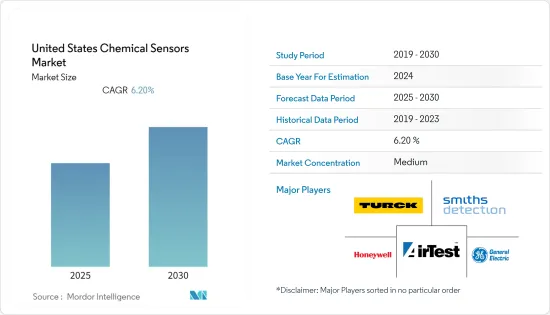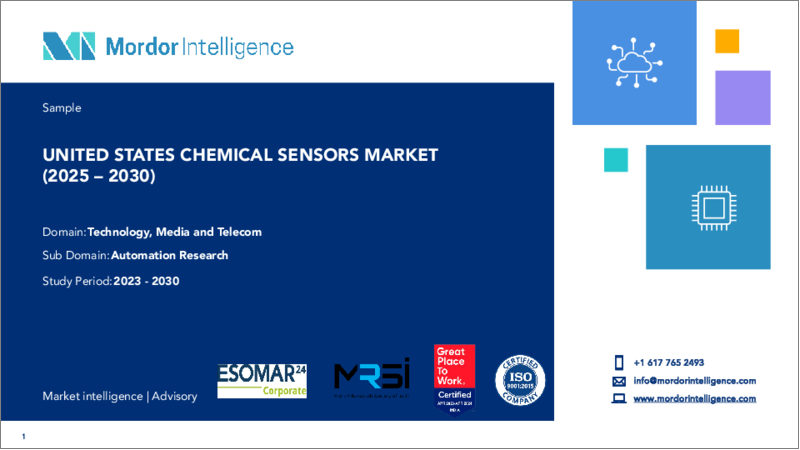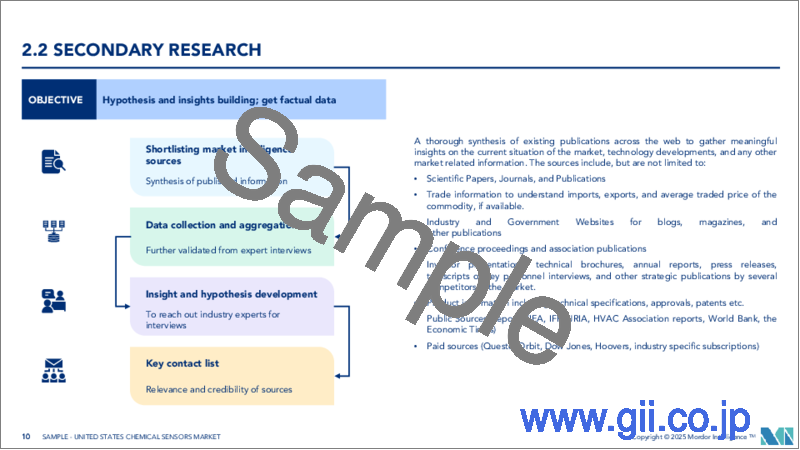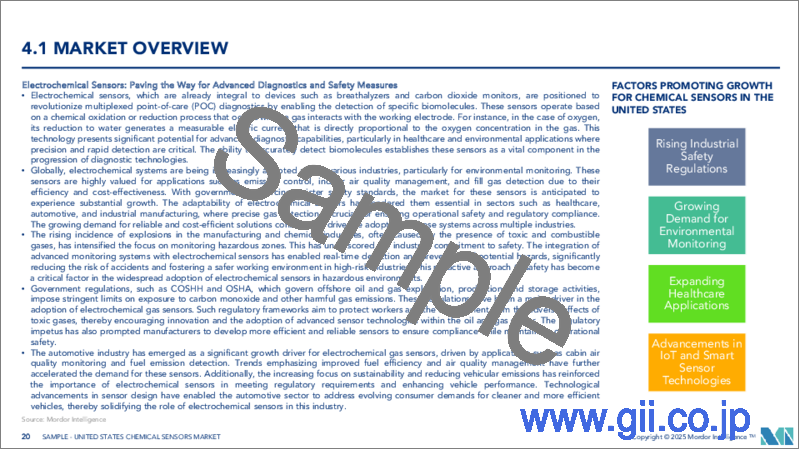|
|
市場調査レポート
商品コード
1627178
米国の化学センサー:市場シェア分析、産業動向、成長予測(2025~2030年)United States Chemical Sensors - Market Share Analysis, Industry Trends & Statistics, Growth Forecasts (2025 - 2030) |
||||||
カスタマイズ可能
適宜更新あり
|
|||||||
| 米国の化学センサー:市場シェア分析、産業動向、成長予測(2025~2030年) |
|
出版日: 2025年01月05日
発行: Mordor Intelligence
ページ情報: 英文 120 Pages
納期: 2~3営業日
|
全表示
- 概要
- 目次
概要
米国の化学センサー市場は予測期間中にCAGR 6.2%を記録する見込み

主なハイライト
- 化学センサーは、MEMSとナノテクノロジーの出現によって技術的に進化しました。小型化により、電気的、機械的、化学的、触媒的、光学的な新しい特性を導入できることがわかっています。
- カーボンナノチューブ、酸化亜鉛ナノワイヤー、パラジウムナノ粒子など、さまざまなタイプの検出素子が、ナノテクノロジーに基づく化学センサーにすでに使用されています。
- 化学センサーの用途は、医療分野で増加しています。これらのセンサーは、人体内の化学物質の濃度など、ガス状の問題の診断に使用されます。MEMSセンサーはバイオテクノロジーの開発に大きな影響を与え、研究者に体内およびそのさまざまな複雑なサブシステム内の化学物質や生物学的化合物を検索し、影響を与える能力を提供しています。これにより、病気の状態を特定し、予防する複数の方法が生み出されています。
- 米国が大きなシェアを占めています。米国国勢調査局によると、65歳以上の人口は2018年の5,200万人から2060年には9,500万人に増加すると予想されています。高齢者層のシェアは16%から23%に上昇すると予想されています。したがって、この国はがん、呼吸器疾患、糖尿病などの病気にかかりやすいです。
- したがって、ヘルスケア支出の増加と疾病の発生率の増加により、米国は化学センサー市場に大きく貢献すると予想されます。さらに、米国政府は各家庭にCOガス漏れ検知器の導入を義務付ける規制を導入しています。
米国の化学センサー市場動向
医療分野が大きく成長
- バイオメディカルとヘルスケア分野は、化学センサーの重要な市場の一つです。これは主に、小型、迅速、正確で携帯可能な診断センシングシステムに対する需要の増加によるものです。
- 原材料のコストが低く、製造プロセスにおけるナノマイクロ加工技術の出現により、ヘルスケア用途の化学センサーの商業化が大幅に増加しています。
- さらに、ナノテクノロジーの出現により、化学センサーの動作特性は劇的に変化し、市場で重要性を増しています。診断用の体外センサーにはさまざまな進歩があり、まもなく発売される開発品もいくつかあります。また、化学ナノセンサーを用いたポイントオブケア診断も可能です。
- 電気化学センサーを用いた分子POC(ポイント・オブ・ケア)診断は、既存の近接患者の感度を向上させ、迅速な検査を実行し、世界中の医院や病院の重症治療室、外来診療所などのポイント・オブ・ケアでの診断能力を拡大する能力により、支持を集めています。
- さらに、糖尿病治療用の埋め込み型グルコースセンサー開発における精密印刷・加工技術の進歩や次世代の医療・診断用電気化学バイオセンサー製品設計は、血管内や皮下への応用が開発されています。
電気化学センサーは徐々に成長する
- 特定の生体分子を同定するように設計された電気化学センサーにより、多重化されたPOC診断が現実になる可能性があります。呼気分析器、呼吸用二酸化炭素センサー、一酸化炭素センサーなどの電気化学センサーは、有害ガス、酸素、その他の空気中の分子を検出するためにすでに使用されています。ガスがセンサーの電極(作用電極と呼ばれる)のひとつに当たると、化学的な酸化または還元プロセスが起こる。例えば、酸素が水に還元されると、電子が対極(または参照電極)から作用電極に流れ、ガス中の酸素量に比例した電流が測定されます。
- 電気化学システムは現在、世界中のさまざまな企業で使用されています。電気化学システムは、環境モニタリングや管理、その他の機器に頻繁に使用されています。電気化学式ガスセンサーは、いくつかの用途を挙げれば、排気ガス制御、室内空気品質、効果的な複数ガス検知能力を持つ充填ガス検知、コスト効率などで高い需要があります。さらに、様々な政府によって厳しい安全基準が課された結果、この業界は今後数年で発展すると予想されています。
- 有毒ガスや可燃性ガスの存在により、製造業や化学工業の極限環境で発生する爆発事故が増加しているため、より安全な作業環境を実現するために、これらのエンドユーザー産業の危険区域全体にわたる暗黙のモニタリングによる爆発防止への注目が高まっています。
- さらに、COSHH規制やOSHA規制のような、オフショア石油・ガス探査、生産、貯蔵活動を管理する政府の規則は、一酸化炭素やその他の危険なガスの排出にさらされることを厳しく制限しています。これは、電気化学技術に基づくガス・センサーの採用における主要な推進力となっています。
- 自動車産業は、キャビンの空気品質や燃料排出ガス検知器などの新しいアプリケーションのおかげで、積極的な成長を見せています。電気化学ベースのガスセンサー産業の顕著な原動力は、燃費改善や空気品質管理といった動向の調整です。
米国の化学センサー産業概要
米国の化学センサー市場は中程度に統合されており、多くの市場企業がごくわずかなシェアを占めています。地域市場の開拓と海外直接投資における現地企業のシェア拡大が、市場の断片化を促進する主な要因となっています。
- 2021年3月産業オートメーション、スマートインフラ、ロボット、自動車業界向けに高解像度デジタル・ライダーセンサーを提供するOuster Inc.は、戦略的委託製造業者であるBenchmark Electronics社との提携により、自動車向けの主要マイルストーンを達成しながら生産規模を拡大すると発表しました。同社は、ベンチマークとの提携は、4つの市場セグメントにわたる現在のニーズを満たし、自動車関連顧客の予想される大量需要に対応する能力を加速させるものであると強調しました。一方、ボッシュは高性能加速度計、IMU、圧力センサーを10年間供給可能な形で発売しました。
- 2021年1月:ペタセンスは、振動、温度、速度を備えた初の3-in-1産業用センサーを発表。VSxに統合された速度検出機能により、ユーザーは指定された速度範囲内、または資産が動作している間のみ測定を行うことができます。内蔵されたスマートセンシングにより、センサーは相互に通信し、アセットトレイン上の複数のセンサーに同期した測定値を提供することができます。その後、ファブレス半導体の新会社であるFlussoは、コネクテッドデバイスサービスプロバイダーであるPelionと共同開発パートナーシップを締結し、産業領域全体におけるコネクテッドフローセンシング製品とシステムの開発と展開を加速させる。
その他の特典
- エクセル形式の市場予測(ME)シート
- 3ヶ月間のアナリストサポート
目次
第1章 イントロダクション
- 調査の前提条件と市場定義
- 調査範囲
第2章 調査手法
第3章 エグゼクティブサマリー
第4章 市場洞察
- 市場概要
- COVID-19が業界に与える影響
- 業界の魅力度-ポーターのファイブフォース分析
- 新規参入業者の脅威
- 買い手の交渉力
- 供給企業の交渉力
- 代替品の脅威
- 競争企業間の敵対関係
- 技術スナップショット
第5章 市場力学
- 市場促進要因
- 小型化・携帯型電気化学センサーの開発拡大
- 自動車とヘルスケア分野での採用増加
- 市場の課題
- 高度なセンサーアプリケーションに対する厳しい性能要件が市場成長の課題
第6章 市場セグメンテーション
- 製品タイプ別
- 電気化学
- 光学式
- パリスター/触媒ビーズ
- その他の製品タイプ
- 用途別
- 産業用
- 医療用
- 環境モニタリング
- 防衛・国土安全保障
- その他の用途
第7章 競合情勢
- 企業プロファイル
- AirTest Technologies Inc.
- Smiths Detection Inc.
- General Electric
- Hans Turck GmbH & Co. KG
- Honeywell International Inc.
- MSA Safety Incorporated
- Pepperl+Fuchs Group
- SenseAir AB
- SICK AG
- Siemens AG
第8章 投資分析
第9章 市場の将来
目次
Product Code: 50331
The United States Chemical Sensors Market is expected to register a CAGR of 6.2% during the forecast period.

Key Highlights
- Chemical sensors have evolved technically with the advent of MEMS and nanotechnology. It has been found that with the reduction in size, novel electrical, mechanical, chemical, and catalytic, optical properties can be introduced.
- Various types of detecting elements, such as carbon nanotubes, zinc oxide nanowires, or palladium nanoparticles, have already been used in nanotechnology-based chemical sensors.
- The applications of chemical sensors have witnessed a rise in the medical sector. These sensors are used for the diagnostics of gaseous issues, such as the concentration of chemicals in human bodies. The MEMS sensors have a massive impact on the development of biotechnology, offering researchers the ability to search for and influence chemical and biological compounds in the body and its various complex subsystems. This has led to multiple ways of identifying and preventing illnesses conditions.
- The United States accounts for a significant share. According to the United States Census Bureau, the number of people aged 65 years and above is anticipated to augment from 52 million in 2018 to 95 million by 2060. The share of people of the older age group share is expected to rise from 16% to 23%. Hence, the country is prone to diseases, such as cancer, respiratory diseases, and diabetes.
- Thus, due to rising healthcare expenditure and increasing incidence of diseases, the United States is expected to contribute to the chemical sensors market significantly. Additionally, the government of the United States has introduced mandatory regulations to compel the adoption of CO gas leak detectors in every home.
US Chemical Sensors Market Trends
Medical Segment will Witness a Significant Growth
- The biomedical and healthcare sector is one of the significant markets for chemical sensors, primarily owing to the increasing demand for compact, rapid, accurate, and portable diagnostic sensing systems.
- The low cost of raw materials and the advent of nano and microfabrication techniques within the manufacturing process have led to a significant increase in the commercialization of chemical sensors for healthcare applications.
- Moreover, with the advent of nanotechnology, the operating characteristics of chemical sensors have dramatically changed and are gaining importance in the market. There have been different advances in in-vitro sensors for diagnostics, with a few developments about to be launched shortly. Also, point-of-care diagnostics are possible with chemical nanosensors.
- Molecular point-of-care (POC) diagnostics using electrochemical sensors have gained traction owing to their ability to improve the sensitivity of existing near-patients, perform rapid tests, and expand the diagnostic capabilities at point-of-care, such as physician offices and hospitals critical care units, and outpatient clinics across the world.
- Further, advancements in precise printing and processing technology and next-generation medical and diagnostic electrochemical biosensor product designs in developing implantable glucose sensors for treating diabetes have been developed for intravascular and subcutaneous applications.
Electrochemical Sensor will Observe Gradual Growth
- Multiplexed POC diagnostics could become a reality due to electrochemical sensors designed to identify specific biomolecules. Electrochemical sensors, such as breathalyzers, respiratory carbon dioxide sensors, and carbon monoxide sensors, are already used to detect harmful gases, oxygen, and other airborne molecules. The chemical oxidation or reduction process occurs when gas hits one of the sensor's electrodes, known as the working electrode, depending on the gas to be examined. For example, when oxygen is reduced to water, electrons flow from the counter (or reference) electrode to the working electrode, resulting in an electric current that can be measured and is proportional to the amount of oxygen in the gas.
- Electrochemical systems are now used in a variety of enterprises across the world. They are frequently used for environmental monitoring and management, as well as other appliances. Electrochemical gas sensors are in high demand for emission control, indoor air quality, fill gas detection with effective multiple gas detection capability, and cost efficiency, to name a few applications. Furthermore, the industry is expected to develop in the approaching years as a result of severe safety standards imposed by various governments.
- Due to an increase in the number of explosions occurring in the extreme environment of the manufacturing and chemical industries due to the presence of toxic and combustible gases, an increased focus on explosion prevention through implicit monitoring across the hazardous zones of these end-user industries has prompted an increased focus on explosion prevention through implicit monitoring across the hazardous zones of these end-user industries to achieve a safer working environment.
- Furthermore, government rules governing offshore oil and gas exploration, production, and storage activities, such as COSHH and OSHA regulations, place rigorous limitations on exposure to carbon monoxide and other dangerous gas emissions. This has been a major driver in the adoption of gas sensors based on electrochemical technology.
- The automotive industry has seen positive growth, owing to new applications such as cabin air quality and fuel emission detectors. A prominent driver for the electrochemical-based gas sensor industry has been aligning trends such as improved fuel efficiency and air quality control.
US Chemical Sensors Industry Overview
The United States Chemical Sensor market is Moderately Consolidated, with many market players cornering a very minimal share in the market. The development of regional markets and increasing shares of local players in foreign direct investments are the major factors promoting the fragmented nature of the market.
- March 2021: Ouster Inc., a provider of high-resolution digital lidar sensors for the industrial automation, smart infrastructure, robotics, and automotive industries, announced scaling of production while achieving major automotive milestones through its partnership with Benchmark Electronics a strategic contract manufacturer. The company highlighted that the partnership with Benchmark is to meet current needs across four market segments and accelerate the capacity to meet the anticipated high volume demands of automotive customers. Bosch, on the other hand, launched a high-performance accelerometer, IMU, and pressure sensor with 10-year availability.
- January 2021: Petasense launched its first 3-in-1 industrial sensor with vibration, temperature, and speed. Integrated speed detection within the VSx allows users to take measurements only during the specified speed ranges or when the asset is operating. Embedded smart sensing allows the sensors to communicate with each other, providing synchronized readings across multiple sensors on the asset train. Subsequently, Flusso, a new fabless semiconductor company, signed a joint development partnership with Pelion, a connected device service provider, to accelerate the development and roll-out of connected flow sensing products and systems across the industrial domain.
Additional Benefits:
- The market estimate (ME) sheet in Excel format
- 3 months of analyst support
TABLE OF CONTENTS
1 INTRODUCTION
- 1.1 Study Assumptions and Market Definition
- 1.2 Scope of the Study
2 RESEARCH METHODOLOGY
3 EXECUTIVE SUMMARY
4 MARKET INSIGHTS
- 4.1 Market Overview
- 4.2 Impact of COVID-19 on the Industry
- 4.3 Industry Attractiveness - Porter's Five Forces Analysis
- 4.3.1 Threat of New Entrants
- 4.3.2 Bargaining Power of Buyers
- 4.3.3 Bargaining Power of Suppliers
- 4.3.4 Threat of Substitutes
- 4.3.5 Intensity of Competitive Rivalry
- 4.4 Technology Snapshot
5 MARKET DYNAMICS
- 5.1 Market Drivers
- 5.1.1 Growing Developments in Miniaturised and Portable Electrochemical Sensors
- 5.1.2 Increased Adoption from Automotive and Healthcare Sector
- 5.2 Market Challenges
- 5.2.1 Stringent Performance Requirements for Advanced Sensor Application challenge the Market Growth
6 MARKET SEGMENTATION
- 6.1 By Product Type
- 6.1.1 Electrochemical
- 6.1.2 Optical
- 6.1.3 Pallister/Catalytic Bead
- 6.1.4 Other Product Types
- 6.2 By Application
- 6.2.1 Industrial
- 6.2.2 Medical
- 6.2.3 Environmental Monitoring
- 6.2.4 Defense and Homeland Security
- 6.2.5 Other Applications
7 COMPETITIVE LANDSCAPE
- 7.1 Company Profiles
- 7.1.1 AirTest Technologies Inc.
- 7.1.2 Smiths Detection Inc.
- 7.1.3 General Electric
- 7.1.4 Hans Turck GmbH & Co. KG
- 7.1.5 Honeywell International Inc.
- 7.1.6 MSA Safety Incorporated
- 7.1.7 Pepperl+Fuchs Group
- 7.1.8 SenseAir AB
- 7.1.9 SICK AG
- 7.1.10 Siemens AG






